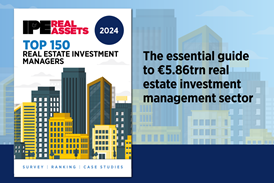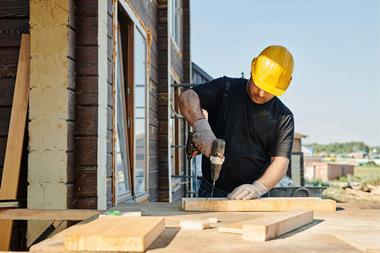As more real estate organisations make net-zero commitments, there is one aspect that is often swept under the carpet – how to decarbonise existing assets, writes Tom Saunders

The majority of real estate assets we currently use – up to 75% – are expected to still be in use by 2050. With the expectation that many governments around the world will make net-zero buildings mandatory in order to reach net-zero emissions globally by 2050, that creates a significant challenge for the existing building stock.
Older assets tend to consume more energy and other resources to keep them running, meaning decarbonisation is essential to reduce emissions but will also require higher effort. Yet without this decarbonisation effort, many existing assets could become unlettable or potentially unusable as legislation changes, creating a pressure on asset owners to take action.
Companies, therefore, have two options – refurbish existing stock to bring it up to net-zero standards or demolish and start again.
While it might be tempting to demolish and start again, the materials used to construct new buildings use energy. That means existing buildings are a huge store of embodied carbon, which should be considered when making this decision. Simply demolishing them and starting again is, for the large part, not an option unless the environmental cost of refurbishment is higher than the total lifecycle carbon impact of a new build.
That leaves us with having to deal with the challenge of decarbonising existing assets, if we are going to come close to achieving net zero targets by 2050 or by any other date. So how can we go about tackling green retrofits and creating a plan for existing buildings that helps meet carbon targets?
The first step to a green retrofit plan is to understand the scale of the problem. It would be wrong to simply assume that, because an asset is old, it is inherently inefficient. The starting point is to understand the difference between how much energy a building was designed to use versus the current building regulations. As building regulations change over time, so do the minimum performance standards. By comparing the modelled asset potential, you can get a clear understanding of what it would take to bring your building up to current building codes. Once you have that understanding, you can evaluate what actions you need to take to improve its energy performance and other related attributes such as air tightness, to move it beyond building code towards net zero.
The key here is to be able to quantify the impact of potential improvements, both in terms of reduced carbon and costs. The underlying principle is that meeting net-zero targets is not about offsetting impact, but rather using the energy hierarchy to reduce the energy demand of the assets. From there, it’s about improving the asset’s efficiency and increasing the amount of renewable energy, primarily from generating renewable energy onsite and procuring renewable energy offsite, if needed. Offsetting any remaining carbon is the last resort.
The challenge with this approach is having robust and independent data at your fingertips to allow you to model and compare solutions to show which solutions work best for different types of building, in different locations around the world. This immediately sounds intensive and costly in terms of time for one building asset, let alone a for a portfolio.
The good news is that there are tools out there such as EDGE to do this for you. EDGE is a green building standard and certification scheme that was created by IFC, part of the World Bank Group, to allow anyone to understand the resource efficiency of a building (or a group of buildings at portfolio level for that matter) and compare it to a local baseline. EDGE includes a freely available app, which contains local baselines and a list of efficiency measures that can make the building ‘greener’. By democratising access to data, every real estate owner, investor, designer or developer around the world can develop a refurbishment action plan and lay out exactly how to get to move towards net zero.
Retrofit at scale with green finance
While the refurbishment of an individual building can be beneficial in its own right, we need to look at retrofitting at scale to help reduce costs, attract investors interested in higher volume and therefore improve payback. This highlights an increasingly important factor: a successful green retrofit plan needs the support of external capital and the full commitment of lenders and investors.
It is encouraging to see how the finance sector is now addressing how it can support green retrofits. A recent report by the organisation Bankers for NetZero in the UK, for example, called for a “retrofit revolution” that would improve the energy performance of the UK’s homes and offices. The recommendations call for a strategy that would deliver at least a 50% reduction in energy usage and carbon footprints, with a potential to deliver a 100% reduction. They calculated that retrofitting the UK’s building stock with low-carbon solutions could reduce national energy costs by £7.5bn a year, cut carbon by 20% and also create more than 150,000 jobs over a 10-year period.
For retrofit projects to access finance, investors often ask for two things: a certain size of the investment, and a green building certification. This is where a portfolio strategy becomes very useful. By mapping out a plan to upgrade all of a company’s assets to net zero, companies can develop a compelling business case to take to financiers to access the capital to deliver the strategy. Individual retrofit projects tend to be too small to be financed by larger banks but when aggregated together into a portfolio strategy, they become very compelling for green finance.
These assets can then go through certification to mark milestones in the long-term strategy. Green building certification provides independent recognition and assurance that green building measures are being implemented. It is a vital component of many of the green financing schemes that are being introduced and provides assurance to a wide range of stakeholders including future owners and occupiers.
Decarbonisation of existing assets is not going to be easy, but there is a clear path forward. With actionable data, clear retrofit plans and an aggregated approach for portfolios of buildings, companies can access the financing they need to make the retrofit revolution a success. And with financing increasingly available for decarbonisation efforts, companies have all the tools required to take action.


















